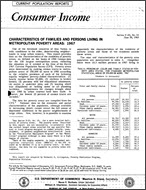Characteristics of Families and Persons Living in Metropolitan Poverty Areas: 1967
Characteristics of Families and Persons Living in Metropolitan Poverty Areas: 1967
One of the foremost concerns of this Nation is with conditions in the older, deteriorating neighborhoods in large urban centers. This report provides data on the characteristics of the residents of poverty areas, as defined on the basis of 1960 Census data for the 100 largest metropolitan areas, reflecting the situation as it existed at the time of the March 1967 Current Population Survey (CPS). Poverty areas were determined by ranking census tracts in metropolitan areas of 250,000 or more in 1960 according to the relative presence of each of the following equally weighted poverty-linked characteristics: (1) family income below $3,000; (2) children in broken homes; (3) persons with low educational attainment; (4) males in unskilled jobs; and (5) housing which was dilapidated or lacking some or all plumbing facilities. Adjustments for changes brought about since 1960 by urban renewal have been made. In general, the lowest 22 percent of census tracts are included.1
The data for poverty areas are compiled from the CPS.2 National data on the economic and social characteristics of the population, although available in increasing detail, cannot reveal the full extent of depressed conditions in the poorer neighborhoods of large cities. Now, however, it is possible to examine separately the characteristics of the residents of poverty areas and those of the residents outside these areas.
__________
1 See Series P-23, No. 19, for a more detailed definition of poverty areas. The poverty areas described in this report are not necessarily co-extensive with the current target areas selected for any specific Federal or local program designed to combat poverty, unemployment, or general neighborhood deterioration (such as the "Concentrated Employment Program" or the ''Model Cities" program) although in many cases there is a high degree of overlap.
2 Each of the sample segments in large standard metropolitan statistical areas (SMSA's) in the CPS is coded as to whether it is in a poverty tract. In tabulation, the data for all segments in poverty areas are combined.
A Note on Language
Census statistics date back to 1790 and reflect the growth and change of the United States. Past census reports contain some terms that today’s readers may consider obsolete and inappropriate. As part of our goal to be open and transparent with the public, we are improving access to all Census Bureau original publications and statistics, which serve as a guide to the nation's history.
Others in Series
Publication
Publication
Publication




